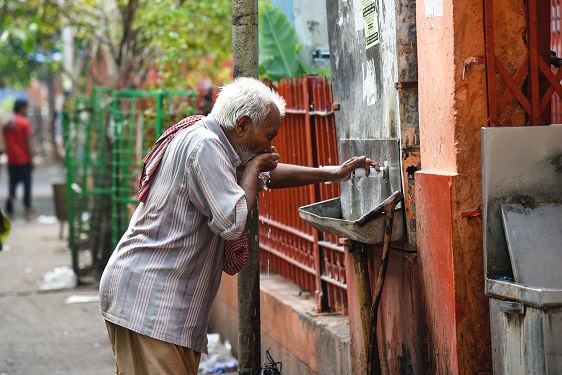Clean Water, Livable Communities & Social Justice Are Linked
In the 1990s, social justice became part of the Miss America pageant, with each contestant required to promote awareness of a particular cause. At the 93rd annual pageant on Sunday, Sept. 9, one candidate took the social justice platform requirement a step further.
As the 51 contestants introduced themselves in snippets of about 10 seconds, Miss Michigan, with an official platform that supports victims of sexual violence, chose to highlight a glaring issue that has plagued her state for the last few years.
“From the state with 84 percent of the U.S. fresh water but none for its residents to drink, I am Miss Michigan Emily Sioma,” she announced.
The decision to feature the ongoing water crisis in her home state was essentially a no-brainer, Sioma told Cosmopolitan. “I knew I had, well, basically eight seconds on TV to make a statement and I wanted to use it for something more than for myself,” she said.
Fighting for Access to Clean Water
In 2016, a state of emergency was declared in Flint, Michigan, due to lead contamination in the city’s water supply. And for two years, Flint residents relied on bottled water as their primary source of hydration.
While the water supply in Flint was deemed “stable” in April 2018, there’s still a lot of work to do to ensure that residents throughout the state of Michigan have access to clean, safe drinking water. High lead and copper levels have been found in the water supply of more than 70 water systems across the state, including Lansing and Grand Rapids.
Michigan’s water crisis is just a small chunk of a far-reaching problem, however, one that is directly linked to social justice. Globally, 783 million people do not have access to clean water, according to Ohio University.
Further, the institution claims that widespread access to clean water can improve living conditions for countless people worldwide, by reducing disease and conflict while increasing school attendance and improving impoverished communities.
But having safe water to drink is just a small piece of a much more complicated puzzle where social justice is concerned.
Will Livable Communities Improve Social Justice?
Along with safe drinking water, community and mobility are vital to fostering socioeconomic equality and improved sustainability.
Ray LaHood, who served as the U.S. secretary of transportation during the Obama Administration, helped bring the term “livable community” into the mainstream. He was a passionate proponent of high-speed rail and bike-share programs, and advocated for affordable and convenient transportation for all citizens.
Although LaHood resigned from his post in 2013, he continues to support improved public transportation and infrastructure across the country.
A livable community is one that is walkable, says LaHood, but it’s much more. In a livable community, mobility, social justice, and urban planning intertwine to foster improved quality of life and overall wellbeing of all residents, no matter age, race, or socioeconomic status. Thus, livable communities are inclusive, sustainable, and perhaps the key to economic and social equality.
It’s important to note that an eco-friendly community isn’t necessarily a livable one, and vice-versa. Some of the top eco-friendly communities in the U.S., for instance, rank highly in regards to recycling rates, energy efficiency, and outdoor recreation options, but lack the quality public transportation that defines a livable community.
Opening the Doors to Conversation
LaHood and Sioma are two excellent examples of how passionate citizens can utilize their public role or occupation as a platform for activism.
Quality of life issues are a major talking point for politicians, social workers, public figures such as Miss America, and more. Like Sioma, individuals in those and similar influential roles shouldn’t shy away from bringing social justice topics, such as clean water, infrastructure, and livable communities, into everyday conversation.
While Sioma didn’t make it to Miss America’s semifinal round, comprised of only 15 candidates, she will continue to use her time as Miss Michigan to help provide a voice for the disenfranchised residents of her community and beyond.
“I’m here to help open the door for the conversations to happen, to keep the balls rolling, and to uplift the voices of the leaders in the movements in these communities,” Sioma said. “We’ve got one Earth…and we have the obligation to make sure we’re doing the most we can to make life a little bit better for the people [in those communities] around us.”
What is your opinion on social justice, clean water and how we improve communication to help change and makes sure that all people have sustainable water and living conditions?
Please share this article to help spread the word of social justice and improve living conditions for all people on our planet.



Pingback: Are Home Water Filters Effective and How They Work?
Such a very helpful post. We live somewhere where water isn’t an issue, but I am very aware that we are privileged in that. I am saving this for later to read again and absorb!
#goinggree
Access to clean drinking water is not, as far as I am aware, an issue in France but access to public transport often is. I live 2kms outside a village and 13kms from the nearest town. When we first moved here there was a bus into town but that stopped leaving the nearest public transport 13kms away. However the local authority has just introduced something called a P’tit Bus which has a route that includes our village. It’s a very small electric bus/people carrier that is timetabled to leave and return to the village a couple of times a day but you have to request it otherwise it will not come. I have no idea how well it will be used and I am looking at it as an option to get the boys home from school when they finish early and don’t want to wait to take the school bus. To date it has not been publicised greatly so I do hope more people will get to know about it and use it otherwise it will not continue. #GoingGreen
HI Rosie,
It is very different here in the US, but I am happy to know that you have clean water in France. Public transportation is also not easily available in many areas. Have a healthy, happy & blessed day. Thanks for hosting #GoingGreen Linky.
Thanks for another excellent article. Funny, I had never made this link, but it really is crucial!
HI Nancy,
Glad you found my article helpful. Clean water and livable communities are a part of social justice and that everyone should have the right to. Thanks for stopping by and commenting. Have a healthy, happy & blessed day!